
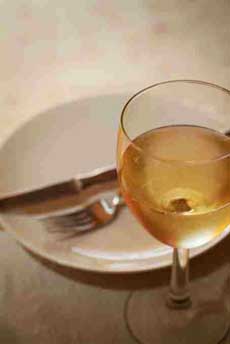 We pair a Vouvray Sec—a dry white wine—with red meat, to great success
We pair a Vouvray Sec—a dry white wine—with red meat, to great success.
|
R. VERONIQUE FITZGERALD is wine consultant and writer in New York City.
|
|
February 2007 |
 |
Product Reviews / Main Nibbles / Wine
A Surprising Pair: Vouvray & Skirt Steak
Matching Wines With Favorite Dishes
CAPSULE REPORT: In the first article of this series, which pairs popular foods with non-traditional wine choices, wine writer R. Veronique Fitzgerald selects skirt steak, adds an Asian marinade and matches it with Vouvray. Beef is traditionally paired with red wine (Cabernet Sauvignon, Pinot Noir, Syrah, Shiraz, Zin...the list goes on), so this is an outside-the-box choice.
When my husband Shehu and I have the same day off together, we do dinner. Sometimes, we go to the markets (super- and/or farmers’) and see what looks good. Recently we found two skirt steaks, each between six and eight ounces. Shehu thought an Asian theme would be easy and delicious. As a treat, we made crème brulée for dessert.
Main Dish: Asian-Marinated Skirt Steak
While many people think that red meat requires a red wine, the skirt steak preparation, caramelized with honey and marinated with Asian flavors, affords pairing with a dry white wine. Not every dry white wine works: the particular qualities o the Chenin Blanc grape, from which Vouvray is made, make it work. Read more about the pairing in Enjoying The Meal, below.
Ingredients
- Skirt Steak
- Savoy Cabbage, carrots shiitake mushrooms
Asian Marinade
Click on the links to read NIBBLE articles on these topics.
Skirt steak is thin, and will get to a good rare quickly on a high heat skillet. Shehu drizzled a bit of honey to caramelize during cooking, then put the steak on a cutting board, sliced it into thin bites and served it straight from the board. He used the dressing to flavor the stir fry as well, so the two parts of the dish complemented each other nicely. It was savory and spicy overall, with a hint of sweetness, and the stir-fry veggies added a nice crunch to the plate.
The Wine: Vouvray Sec
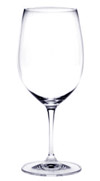 The wine was Domaine Bourillon D’Orleans Vouvray Sec 2005 La Coulée d’Argent ($16.99 plus tax in Manhattan). Tasted in a 250ml (8-ounce) ISO glass (a standard glass, like the one at the right), the nose was intense with mineral, peach and herb aromas. Not all Vouvray Secs will work with beef, but this one does: The attack was sweet and slightly effervescent on a dry, medium-bodied wine. It had an intensely grapey flavor. The alcohol was medium, the acidity medium plus. The wine was Domaine Bourillon D’Orleans Vouvray Sec 2005 La Coulée d’Argent ($16.99 plus tax in Manhattan). Tasted in a 250ml (8-ounce) ISO glass (a standard glass, like the one at the right), the nose was intense with mineral, peach and herb aromas. Not all Vouvray Secs will work with beef, but this one does: The attack was sweet and slightly effervescent on a dry, medium-bodied wine. It had an intensely grapey flavor. The alcohol was medium, the acidity medium plus.
The Riedel Vinum is one of the best red wine glasses you can buy. The Riedel wine is scientifically engineered to maximize the aromas of the wine: there’s a different bowl shape for each grape varietal. The glasses are pricey, but they make any wine you’re drinking taste even better. Click here for more information or to purchase.
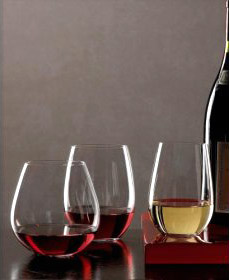
|
I was practicing for an upcoming tasting exam, so I tasted it blind in a flight with two other wines made from the same grape, Chenin Blanc. Once I found out that it was Vouvray, I thought it would be interesting to try the wine in a wider glass. In my 400ml (14-ounce) Riedel O Riesling/Sauvignon Blanc glasses, the wine opened up better, offering lovely, blossom, mineral and tropical aromas. The sweet attack turned into ripe tropical fruit on the palate supported by plenty of acid that made us want another taste. What a difference the glass made!
Riedel O Riesling/Sauvignon Blanc glasses. Riedel makes the finest glassware for wine-tasting. Click here for more information or to purchase.
|
Enjoying The Meal
With the food, very spicy, savory (or umami if you will), flavors coated the palate, conveyed by the juicy, rare steak. The sugars from the honey Shehu drizzled on it caramelized, and the result was tender meat with a sweet and savory crust. Then the Vouvray came in to wash the palate with acidity, liven it up again, and throw tropical fruit flavors into the mix.
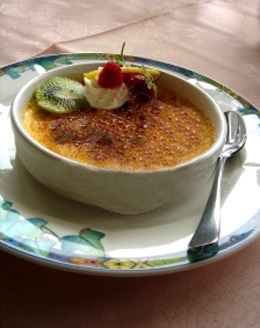
The same dry Vouvray that worked with the
Asian skirt steak also complemented the sweets
we had on hand—cheese danish and crème brulée—although ideally, we would have popped
open a sweeter Vouvray, demi-sec or moelleux,
or an Anjou (see our article on wine and dessert
pairings).
|
The wine was also delicious with the $4.00 supermarket cheese danish ring we nibbled on while we waited for our crèmes brulées to cool in the fridge. The sweet, creaminess of the cheese danish negated the sweet fruit in the wine and exposed crisp, juicy acidity and some herbaceous undertones. It kept the palate clean.
The Vouvray had the same effect on the crème brulée. We had the wine at room temperature. It can also be nice chilled, but not too cold: An overnight stay in a 34°F fridge numbs the flavors, and you need to let the wine warm for 15 minutes before serving (you can pour the wine—it will warm in the glass). Alternatively, a wine at room temperature can spend a couple of hours in the fridge before the meal, and it will chill it just enough. Cellar temperature is around 59°F, the optimum serving temperature for both red and white wines.
|
How To Buy Vouvray
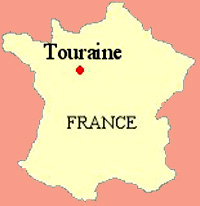 Vouvray (voo-VRAY) is a section of the Touraine region of the Loire Valley in western France where the Chenin Blanc grape is king. Vouvrays are 100% Chenin Blanc. While the Chenin Blancs from the Loire are called Vouvrays, elsewhere in the world where the grape is grown, it is known simply by its varietal name. Chenin Blanc is also grown in abundance in South Africa, where they make more steely, crisp, linear wines that are a steal at $11.00 a bottle or less. Comparably priced Pacific Coast Chenin can be simple and insipid. Paumanok Vineyards on the North Fork of Long Island is the lone producer of fantastic Chenin Blanc in the region. Vouvray (voo-VRAY) is a section of the Touraine region of the Loire Valley in western France where the Chenin Blanc grape is king. Vouvrays are 100% Chenin Blanc. While the Chenin Blancs from the Loire are called Vouvrays, elsewhere in the world where the grape is grown, it is known simply by its varietal name. Chenin Blanc is also grown in abundance in South Africa, where they make more steely, crisp, linear wines that are a steal at $11.00 a bottle or less. Comparably priced Pacific Coast Chenin can be simple and insipid. Paumanok Vineyards on the North Fork of Long Island is the lone producer of fantastic Chenin Blanc in the region.
Vouvray tends to have a sweet but dry flavor. Typical flavors include lemon, fruit and minerals; some vouvray wines have flavors of apples and pears. As with all wines, it will be affected by its terroir, the composition of the soil in which the grape is grown. Vouvrays from clay soil can have a fruitier flavor, while those grown on perruches (flinty clay) soil can have more of a mineral cast. The color is a golden, with the richer, moelleux dessert style tending to deep gold like a Sauternes, with flavors of honey, caramel and prunes. Vouvray goes very well with seafood: it is delicious with lobster and shrimp.
Vouvrays come Sec (dry), Demi-sec (sweeter), Moelleux (moy-YUH, sweet) and Petillant (peh-tee-YONT, sparkling). While our pairing today is with beef, Vouvray sec is a classic white wine, enjoyable for its distinctive, non-Chardonnay character. As with any wine, the price range is broad, starting at around $7.00 a bottle. Age-worthy Vouvray from esteemed producers such as Huët and Foreau (Clos Naudin), can get as pricey as $30.00 for recent vintages, or $60.00+ for older vintages and the nectary-sweet moelleux. A sumptuous 1997 Moelleux from either of these producers will run you as much as $85.00 for a 750ml bottle (they come in 375ml half bottles, as well). Huët’s single vineyard Clos du Bourg and Le Haut Lieu Sec and Demi Sec wines offer great complexity, elegance and minerality at a relatively reasonable $25.00 to $30.00 a bottle, and they age beautifully in good storage. While Vouvray is typically drunk young, within 6 months of bottling (which would be around 3 years from when the grapes are picked), and within two years of its release. Vouvrays from the best producers in top vintage years have been known to drink beautifully at 100 years of age. Like Dorian Gray, they retain their youthfulness when everything that has grown up with them is old and withered.
When you shop for Vouvray, buy two or more wines from different producers, so you can taste them with food and without at your leisure and see whose style you prefer. Make sure you buy current vintages; 2005 is the current vintage on the market, but good 2004s may still be around. Steer clear of 2003s (not a great year) unless you’re buying top producers. Even if you’re not into sweet wines, try some demi-sec as well. A well-made demi-sec will have enough acidity to keep the sweetness from weighing your tongue down. The best of them even finish dry, and the sweetness amplifies the effect of ripe, tropical fruit. Mmmm, tasty!
A glass of Vouvray moelleux—a heavenly, sweet dessert wine—from Domaine Huët.
|
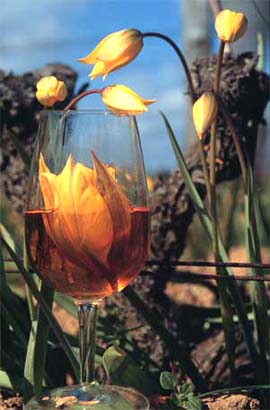
|
Most of the producers recommended in the next section also make a Vouvray Pétillant (pet-tee-YONT), which is their sparkling wine. They start around $12.00 and can be as much as $28.00 a bottle, the price of some non-vintage brut Champagne. These are definitely worth trying. Vouvray Pétillant also comes in dry and off-dry versions. I’ve enjoyed two vintages of Domaine Huët’s version (2003 and 2004, the current release) which were both dry with a lot of richness and honeyed minerality. They were also a great compliment to savory dishes and game. Domaine Champalou’s Pétillant is more reasonably priced and simpler, great for sipping well chilled as a cocktail.
Recommended Producers
At any price range, you can get to know Vouvray. If you can afford to start at the top, go right ahead!
$7.00 to $11.00 Range
- Remy Pannier
- Barton & Guestier
- Sauvion
$12.00 to $18.00 Range
- Marc Brédif
- François Pinon
- Chateau Moncontour
- Château Gaudrelle/Mommosseau
- Domaine Champalou
- Domaine des Aubuisières
Top Producers: $25+
- Domaine Huët (doe-MEN hoo-AY)
- Foreau/Clos Naudin (for-OH cloe noh-DAN)
- Domaine de la Taille aux Loups (doe-MEN duh la TIE oh LOO)
Photo of Domaine Huët.
|
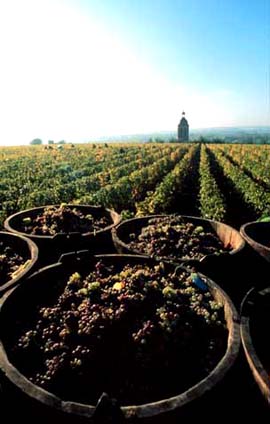
|
Lifestyle Direct, Inc. All rights reserved. Images are the copyright of their respective owners.

|